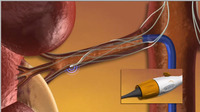
A special session at the CIRSE 2014 conference in Glasgow, UK, took a close look at the field of renal denervation as it stands today and concluded that there is still plenty of life and promise in the field. This is not the end of renal denervation but the beginning of proper evaluation, experts said.
The six-month results of the French randomised controlled trial DENERHTN, presented in the “Randomised trials in Interventional Radiology” session by Marc Sapoval, Hôpital Européen Georges Pompidou, Paris, France, also provided renal denervation with early positive evidence.
The 120-patient DENERHTN study set out to compare the efficacy, safety and cost-effectiveness of renal denervation using the single electrode Symplicity catheter (Medtronic) added to a protocol-driven and stepped care optimised antihypertensive treatment strategy to the same medical strategy alone in patients with confirmed resistant hypertension.The study was conducted in French Hypertension Excellence Centres certified by the European Society of Hypertension,
DENERHTN is an investigator-initiated multicentre, randomised, controlled open-label trial, funded by the French Health Ministry, with the primary endpoint being changes in daytime ambulatory systolic blood pressure from baseline to six months.
“In the very controlled conditions of the DENERHTN trial, renal denervation with the Symplicity catheter combined to a stepped care antihypertensive treatment regimen significantly reduced daytime ambulatory systolic blood pressure by approximately 6mmHg from baseline to six months as compared to the same antihypertensive treatment regimen alone in patients with confirmed resistant hypertension,” Sapoval a co-primary investigator of the trial (with M Azizi, Hypertension Excellence Centre) told delegates.
In terms of secondary endpoints, the percentage of patients with controlled blood pressure on daytime ambulatory blood pressure monitoring in the renal denervation group was 41.7% as compared to 28.3% in the control group. There was also a significant between-group difference of approximately 6mmHG in the systolic blood pressure changes a night. The difference between the two groups in home or office systolic blood pressure changes from baseline to six months was not significant.
The ensuing discussion emphasised that this was a controlled trial that had a standardised antihypertensive regimen and also that patient adherence to medication was monitored using the 8-item Morisky questionnaire (Morisky Medication Adherence Scale [MMAS-]). Alan Matsumoto, Charlottesville, USA, made the point that a post-hoc analysis of the SYMPLICITY HTN-3 trial (the first trial to compare renal denervation to a sham procedure,) has revealed that in Caucasian men, renal denervation did have a significant effect. However, in the Symplicity cohort, there was a large reduction in blood pressure in the African American sham group (that constituted 25% of the study group) which contributed to the results overall, showing no difference in the change in office BP in the study groups at six-months.
Michael Lee, Dublin, Ireland, who presented an overview of the evidence of SYMPLICITY HTN-3 noted that the way forward for renal denervation was to focus on patients with sympathetic overdrive. It was important to develop biomarkers to measure denervation, revisit kidney physiology and its role in hypertension and revisit the sympathetic chain anatomy, he stated. “It is important to identify what type of ablation is required, what the optimum depth of ablation is and the best location,” he said. Lee noted that the results of the SYMPLICITY HTN-3 trial “had put the kibosh on renal denervation, at least in the short-term”. However most experts note that renal denervation is not dead. “This is not the end of renal denervation but the start of a proper evaluation period. Further study in rigorously designed clinical trials is warranted,” Lee told delegates.
Jon Moss, Glasgow, UK, and chairman of the CIRSE RDN Task Force, who outlined the opportunities for renal denervation beyond hypertension as defined by early datasets in heart failure, cardiac arrhythmias, chronic kidney disease, insulin resistance and sleep apnoea, told the audience that the procedure definitely showed promise and needed to be evaluated further. Jim A Reekers, Utrecht, The Netherlands, who moderated the session asked Moss whether he really believed in the promise of denervation to improve these conditions and to confirm that this was not “just a way to keep the field alive” and Moss replied that there was certainly promise in the technology that warranted further investigation.










